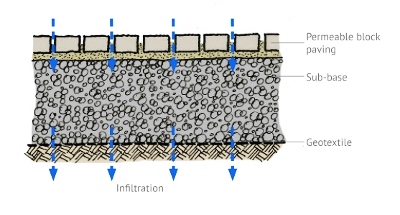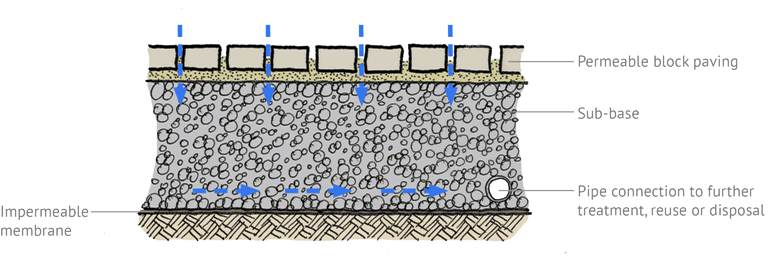- Delivering SuDS
- Using SuDS
- Background
- SuDS principles
- Benefits of SuDS
- Benefits of SuDS
- Why developers should choose SuDS
- Flood risk management
- Water quality management
- Biodiversity & ecology
- Amenity
- Air quality
- Building temperature
- Carbon reduction and sequestration
- Crime
- Economic growth
- Enabling development
- Flexible infrastructure/climate change adaptation
- Education
- Groundwater recharge
- Health and well being
- Pumping wastewater
- Rainwater harvesting
- Recreation
- Tourism
- Traffic calming
- Treating wastewater
- SuDS components
- SuDS components overview
- Source control
- Swales & conveyance channels
- Filtration
- Infiltration
- Retention & detention
- Wetlands
- Inlets, outlets and control structures
- SuDS performance & monitoring
- Delivery
- The costs & benefits of SuDS
- Adoption & maintenance of SuDS
- Legislation & regulation
- Design guidance
- Retrofitting SuDS
- Drainage exceedance
- Home
- Delivering SuDS
- Using SuDS
- SuDS components
- Source control
- Pervious surfaces
- Pervious surface types
- Construction options
Construction options
Dependent upon the surface material and use of the surface, the underlying construction usually consists of a combination of:
-
Soil, sharp sand, crushed rock.
-
One or more layers of different materials e.g. granular and/or geosynthetic layers/geocellular drainage tank.
-
A permeable geotextile or an impervious geomembrane.
It may also include, if necessary, drainage networks to discharge water entering or flowing through the construction.
The outflow from the pervious pavement construction can be achieved in a number of ways:
-
Water within the construction is directed to a drainage network either on the subgrade or within the permeable sub-base which conveys it to a suitable outfall or disposal point.
-
Water entering the pervious surface infiltrates down into the groundwater through the base of the construction.
-
Water is discharged at the base of the construction passing slowly to groundwater and excess waters, which would otherwise fill the construction, are released via a high-level overflow pipe.
-
Water is stored in the construction for suitable non-potable use, any excess being disposed of via a high-level overflow pipe.

Often pervious areas are required only to handle rainfall landing directly upon their surfaces, but their capacity is such that they may also be used to provide a drainage path for water discharged from adjacent areas, such as roofs or impermeable areas of car park. It is advisable to release any additional waters either onto the surface of the pervious construction, or via a debris trap, in order to prevent clogging of the sub-surface layers.
Read more on:




